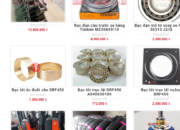Choose container handler or reach stacker?
Choosing between a container handler or a reach stacker to handle loading, unloading and moving containers requires a certain understanding of the characteristics of each of these vehicles. Although both machines are used for similar purposes, the designs of these two forklifts are determined to be robust, flexible, and suitable for the type and operation characteristics of both. type. But how do you decide which machine best meets the operational needs of your business? Samcovina.com has a few things you need to keep in mind as follows:
Storage space, location, type of loading and unloading, lifting
Container handlers and reach stackers differ in storage capacity. For example, if your space allows or forces you to stack containers in two or three rows, a container handler is not suitable for the job. Container forklifts can only handle loading and unloading containers in one row at a time, while reach stackers can stack containers in two or three rows.
See more >>>Electric Forklift
The case of “lifting dead load”
However, the number of rows is not the only thing to consider when deciding between a container forklift and a reach stacker. If you frequently move containers to stack other containers below or behind it: this is a process known in handling businesses as “lifting dead loads.” In this case, a forklift reach stacker will slow down your activity. Instead, a container forklift will help you get the job done faster and more efficiently. On the other hand, a container handler requires less handling time to transfer a container and allows for faster re-stacking.
Load capacity
Reach stackers and container handlers also differ when it comes to load capacity. Reach stackers vary in capacity but most of them are required to have a 3.85 meter load center in the second row of boxes. However, since there is less than 14 cm of clearance between the reach stacker and the cargo containers, it is recommended to adopt a 4.25 meter load center for the second row of stackers instead. Remember, though, that this reduces lifting capacity.
Most container handlers are specified to have a 1.2 meter load center, although it is recommended to adopt a 1.6 meter load center so that it can reach the load object and rotate it.







